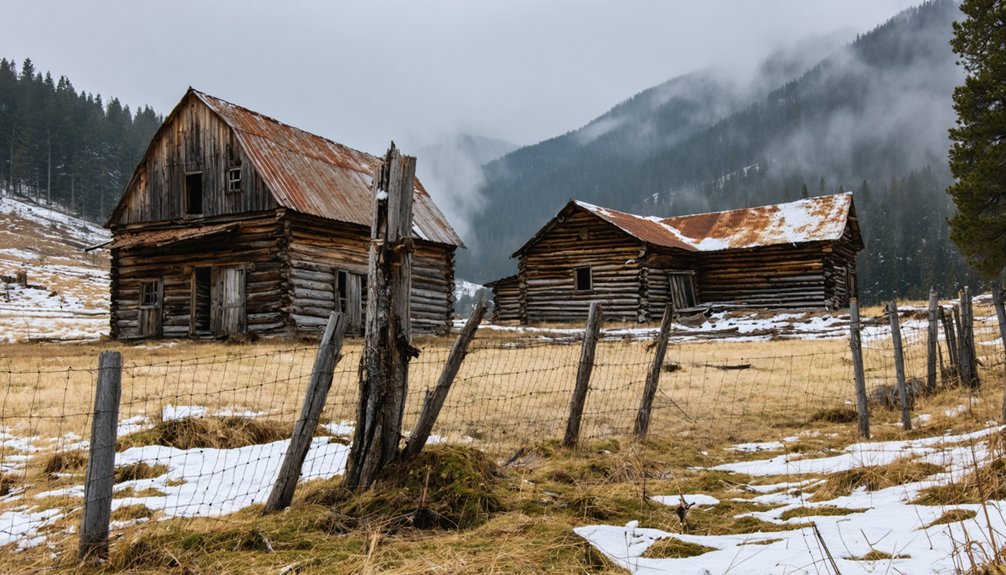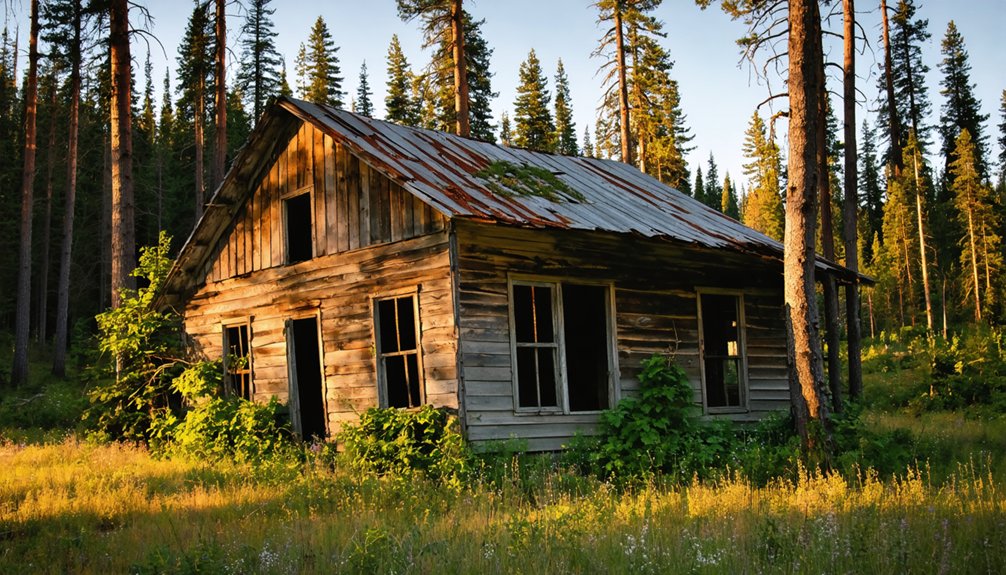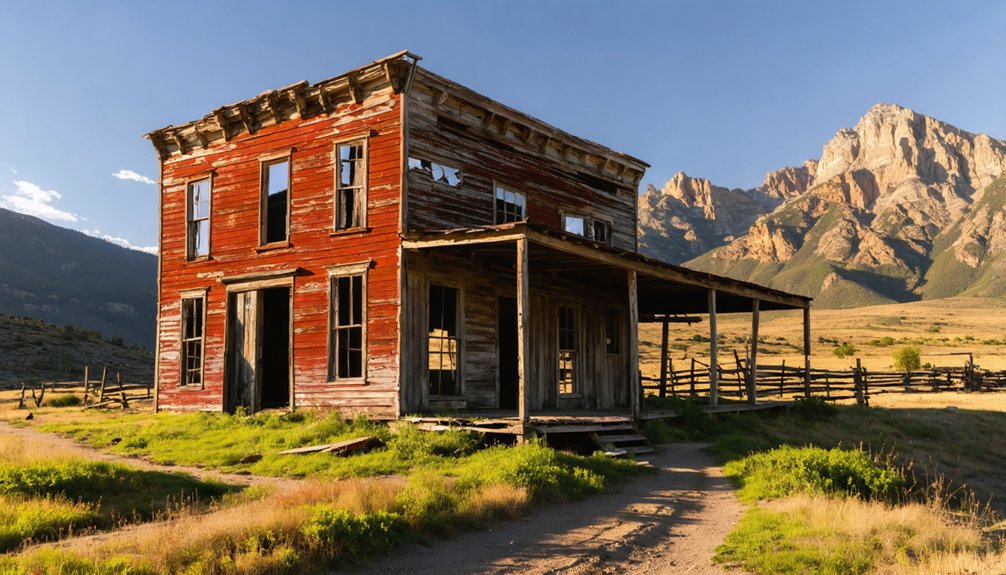You’ll find Florence nestled at 6,080 feet in Idaho’s rugged wilderness, where gold’s discovery in 1861 transformed a 50-person tent camp into a bustling city of 9,000 within months. The Summit Creek Mining District yielded an estimated $6-7 million in its first year alone, equivalent to $1.54 billion by 1985. Today, nature has reclaimed this once-thriving town, where tales of 113-day snowfalls and resilient pioneers echo through abandoned foundations and towering pines.
Key Takeaways
- Florence began as a gold mining boomtown in 1861, growing from 50 to 9,000 people within a year after rich deposits were discovered.
- Located at 6,080 feet elevation, the town faced extreme winters with 113 consecutive days of snow in 1861-1862.
- The mining district produced approximately $9.6 million in gold during its peak, equivalent to $1.54 billion in 1985 values.
- The town featured numerous businesses including ten butcher shops, seven bakeries, saloons, and a Masonic Hall during its heyday.
- Nature has reclaimed the abandoned town site, with native vegetation growing through old foundations and wildlife returning to the area.
The Golden Discovery That Started It All
While prospectors had already struck gold in Idaho’s Orofino Creek during E.D. Pierce’s 1860 expedition, the real gold rush was yet to come.
On August 19-20, 1861, a determined group of 23 prospectors from Elk City made their way into the Florence Basin and struck it rich. You wouldn’t have heard about it right away though – they kept their discovery quiet to stake their claims first.
Their secret didn’t last long. By mid-September, word spread of incredible yields: $20 to the pan and claims producing $100 per day using basic mining techniques. Much like the wealthy Medici family of Renaissance Italy, these early prospectors wielded significant influence over the region’s development.
The news transformed a modest tent camp of 50 souls into a booming city of 9,000 by summer 1862. This explosive growth made Florence one of the fastest-growing boomtowns in the American West. That first year alone, miners extracted an estimated six to seven million dollars worth of gold from the area.
Life in a Booming Mining Town
If you’d visited Florence in 1862, you would’ve found a bustling frontier town with ten butcher shops, seven bakeries, and numerous saloons serving its 9,000 residents.
The town’s social life centered around gambling halls, a dance house, and the Masonic Hall, while some residents enjoyed luxuries like glass windows in their log cabins.
You would’ve also witnessed the remarkable resilience of townspeople who endured 113 consecutive days of snow reaching depths of 10 feet, surviving primarily on flour, water, and “spruce tea” during the harsh mountain winter.
Prosperous Shops and Services
The bustling streets of Florence transformed virtually overnight from a modest tent settlement of 50 people into a commercial powerhouse of 9,000 residents in 1862.
You’d find a robust business infrastructure along Main, Miner, and Pine streets, with ten butcher shops and seven bakeries serving the mining economy. Glass-windowed saloons and sophisticated log cabins with decorative fronts stood alongside simpler structures lit by muslin coverings.
Whether you needed legal counsel from one of eight attorneys or sought entertainment at the gambling halls and “doggeries,” Florence had it all. However, the harsh winter famine of 1861 had tested the town’s resilience before its peak prosperity.
The town’s diverse amenities included a proper dance hall, Masonic Hall, and jail.
With six to seven million dollars in gold dust flowing through the community that year, Florence’s merchants and service providers prospered from the steady stream of miners. The miners earned impressive sums, with successful prospectors bringing in up to $100 daily from their claims.
Daily Life and Culture
Life in Florence during its heyday painted a vivid picture of cultural diversity and social dynamics unique to mining boomtowns. You’d find Chinese and White miners working side by side, contributing to the town’s multicultural fabric.
After a long day of mining, you could attend community events at the Masonic Hall or try your luck at one of the many saloons. If you were in the mood for entertainment, the local dance house provided a chance to unwind and socialize.
The town’s cultural diversity was reflected in its daily activities, with residents from different backgrounds sharing the same streets – Main, Miner, and Pine. You’d see lawyers rubbing shoulders with miners, creating a distinct social hierarchy that defined life in this bustling frontier town.
Surviving Harsh Mountain Winters
Situated at an elevation exceeding 6,000 feet, Florence’s harsh mountain winters posed extreme challenges for miners attempting to strike it rich during the 1860s gold rush.
You’d find yourself battling deep snow and bitter cold, forcing you to suspend mining operations for months at a time. Winter survival meant carefully planning ahead – dragging logs from miles away to build sturdy cabins before the snow hit.
Despite your best preparations, you’d face constant struggles with limited access to supplies and dangerous transportation conditions.
The town’s mining economy followed a brutal boom-and-bust cycle, largely dictated by these seasonal challenges. While some miners developed innovative adaptations to weather the winters, many couldn’t sustain operations, contributing to Florence’s rapid decline by early 1863.
From Tent City to Thriving Community
You’ll find it hard to believe that Florence’s humble beginnings as a 50-person tent settlement transformed into a bustling community of 9,000 residents within just one year of the 1861 gold discovery.
As winter approached, miners rushed to construct more permanent shelters, dragging logs over a mile by hand sled to build sturdy cabins that could withstand the harsh Idaho mountain climate. Like many Idaho mining towns that followed, Florence displayed a blend of lawless frontier culture.
The town’s explosive growth demanded quick adaptation, with residents establishing essential services including multiple butcher shops, bakeries, and saloons along three main streets: Main, Miner, and Pine. The area proved incredibly lucrative, yielding an estimated six to seven million dollars in gold during 1862 alone.
Rapid Population Growth Surge
When gold was discovered in Florence Basin during August 1861, the area transformed from an empty mountainside into a bustling tent city within months.
You’d have seen the population surge from just 50 initial residents to an astounding 9,000 within the first year, as news of the rich gold strikes spread. The mining workforce, consisting primarily of male prospectors, established a thriving community centered around Baboon Gulch.
By late 1861, you’d have found a well-organized town with sawmills, bakeries, butcher shops, and saloons. Population demographics shifted dramatically as the settlement evolved from a simple miners’ camp into a proper town, complete with intersecting main streets and government buildings. This growth pattern mirrored other settlements in the region after Idaho County’s founding in December 1861. Much like Florence, Italy’s rapid modernization occurred when it became Italy’s capital in 1865.
The discovery yielded an impressive 6-7 million dollars in gold during 1862, cementing Florence’s status as a major boomtown.
Winter Cabin Construction Rush
As Florence’s population swelled, the tent city’s fabric shelters proved inadequate for the harsh Idaho winters ahead.
You’d find miners racing against time to construct log cabins before winter’s fury descended upon the settlement. The winter challenges were formidable – snowfall reaching 10 feet deep and temperatures plummeting dangerously low. The rush to build shelter intensified as over 10,000 miners flooded into the area by spring.
Finnish double notching techniques guaranteed tight-fitting logs for insulation, while hand-split shakes protected cabin roofs from the elements. You couldn’t risk poor construction with 113 days of continuous snow ahead.
Settlers worked collectively, hauling timber over a mile distance and quickly erecting 12×12 shelters with post and pile foundations. These weren’t just temporary dwellings – they marked Florence’s transformation from mining camp to established town, complete with a Masonic Hall and thriving businesses.
Weathering the Elements at 6,000 Feet

Life at 6,080 feet demanded extraordinary resilience from Florence’s early settlers, who endured some of Idaho Territory’s most challenging weather conditions.
You’ll find few places that better demonstrate the raw power of mountain weather than this remote outpost, where the winter of 1861-62 brought an astounding 113 straight days of snowfall.
At this elevation, you’d have faced snowdrifts up to 10 feet deep, forcing even the hardiest miners to halt their operations.
The brutal conditions led to numerous deaths as harsh winter conditions claimed the lives of many unprepared miners.
The weather challenges weren’t limited to winter – unpredictable storms could strike year-round, while elevation effects made simple tasks exhausting.
Even getting supplies proved nearly impossible, as the first pack train couldn’t reach Florence until mid-May 1862, leaving settlers to survive on basic rations of flour and spruce tea.
Legacy of the Summit Creek Mining District
The Summit Creek Mining District emerged as one of Idaho Territory’s most remarkable gold-producing regions, transforming from a remote mountain basin into a bustling boomtown practically overnight.
By 1862, you’d have found yourself among 9,000 residents in Florence, where mining practices ranged from placer operations in creek beds to sophisticated quartz extraction at sites like Bear Track Ledge and the HiYu mine.
What’s particularly significant about this district was its cultural integration. In 1869, the community voted to admit Chinese miners, challenging the era’s prevalent discrimination.
The district’s legacy lives on through its impressive gold production – valued at $9.6 million historically (roughly $1.54 billion in 1985) – and its pioneering social infrastructure that included everything from saloons and bakeries to a Masonic Hall, showing how the frontier fostered both wealth and community.
Nature Reclaims the Frontier

Since Florence’s last residents departed in the early 1900s, nature has steadily reclaimed this once-bustling mining town.
You’ll find native pines, firs, and cedars breaking through old foundations while moss and lichen blanket abandoned equipment. The wildlife resurgence is remarkable – deer, elk, black bears, and wolves now roam freely through areas where miners once toiled.
Nature reclaims what humans left behind, as native trees pierce concrete and wildlife roams where industry once dominated.
You can witness nature’s powerful restoration as streams return to their original courses and wetlands regenerate, creating essential habitat for native species.
The ecological balance continues to improve as vegetation stabilizes old tailings piles and forest cover spreads across former streets and mining sites.
What was once a landscape shaped by human industry has transformed into a wild sanctuary where Idaho’s mountain ecosystem thrives unrestrained.
Frequently Asked Questions
Are There Any Remaining Structures Still Standing in Florence Today?
You won’t find any remaining buildings still standing in Florence today, as historical preservation wasn’t possible. Only foundations, an old cemetery, and nature-reclaimed ruins mark where structures once stood.
What Happened to the Native American Populations During Florence’s Mining Boom?
You’ll find Native displacement was severe during Florence’s boom, with Nez Perce people forced from their ancestral lands. Mining operations devastated their traditional hunting grounds, causing lasting cultural impact through the 1860s.
How Did Law Enforcement Handle Crime in Florence During Peak Years?
In a town where crime spread like wildfire, you’d find law enforcement was tragically ineffective. They couldn’t handle basic crime prevention, lacking resources and authority to control Florence’s rampant lawlessness and violence.
Were There Any Documented Paranormal Activities in Florence’s Ghost Town?
You won’t find documented ghost sightings or credible paranormal investigations in Florence. Unlike other Idaho ghost towns with established haunting claims, there aren’t verified reports of supernatural activity from this mining settlement.
What Transportation Methods Did Early Settlers Use to Reach Florence?
You’d reach Florence primarily by foot or horseback, as stagecoach routes weren’t established during initial settlement. Pack animals carried supplies, while limited river navigation helped transport goods from Snake River settlements.
References
- https://westernmininghistory.com/towns/idaho/florence/
- https://www.fs.usda.gov/media/59421
- https://www.youtube.com/watch?v=cNXLTamjFr8
- https://blybooks.com/2022/09/ghost-town/
- https://wheninyourstate.com/idaho/florence-ghost-town-preserves-memories-of-idahos-most-brutal-winter-death-trap/
- https://idaho.idgenweb.org/Town History/florence.htm
- https://www.rusticlens.com/2016/07/05/florence-idaho/
- https://history.idaho.gov/wp-content/uploads/0196.pdf
- https://history.idaho.gov/wp-content/uploads/2018/08/0009.pdf
- https://en.wikipedia.org/wiki/Florence



